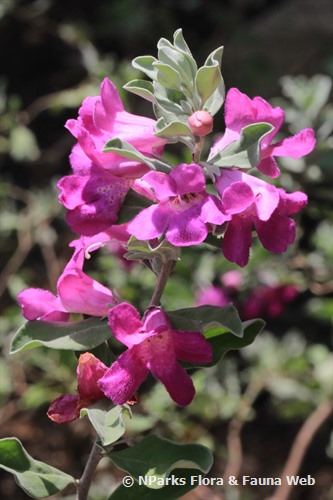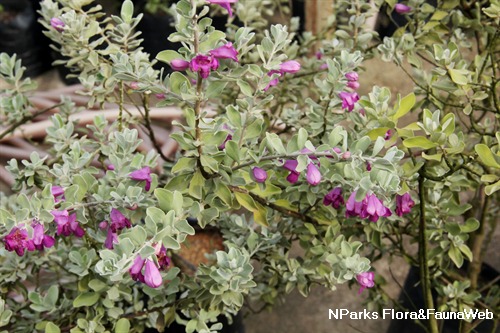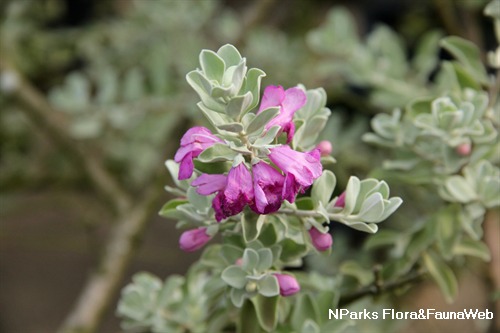
Back
Leucophyllum frutescens
| Family Name: | Scrophulariaceae |
| Synonyms: | Leucophyllum frutescens f. albiflorum, Leucophyllum frutescens f. albineum, Leucophyllum texanum, Terania frutescens |
| Common Name: | Barometer Bush, Ash Plant, Cenizo, Texas Ranger, Texas Silver Leaf, Purple Sage |
Leucophyllum frutescens is an ornamental compact shrub with silver grey leaves and purple tubular flowers. Flowering is triggered when there is significant high humidity especially after rain, hence the common name, Barometer Bush.
Name
Classifications and Characteristics
| Plant Division | Angiosperms (Flowering Seed Plants) (Dicotyledon) |
|---|---|
| Plant Growth Form | Shrub |
| Lifespan (in Singapore) | Perennial |
| Mode of Nutrition | Autotrophic |
| Plant Shape | Shrubby, Open |
| Maximum Height | 1.2 m to 2.4 m |
| Maximum Plant Spread / Crown Width | 1.5 m |
Biogeography
| Native Distribution | Rio Grande Valley (Texas, New Mexico), northern Mexico |
|---|---|
| Native Habitat | Terrestrial (Coastal Forest) |
| Preferred Climate Zone | Tropical, Sub-Tropical / Monsoonal, Desert / Arid |
| Local Conservation Status | Non-native (Horticultural / Cultivated Only) |
Description and Ethnobotany
| Growth Form | Small to medium sized shrub, growing to about 1 - 2.5 m tall and and 0.8 - 1.5 m wide. |
|---|---|
| Crown | Rounded |
| Foliage | Simple, alternate leaves, soft and velvety, bluish grey in colour, measuring up to about 2.5 - 3 cm long, smooth margins. |
| Stems | Squarish, silvery stems |
| Flowers | Flowers are violet to purple, and sometimes pink, measuring about 2.5 cm across, soft and velvety, smooth margins. Blooming usually occurs due to a response to rain and can cover the entire plant. |
| Fruit | Capsule |
| Habitat | Rocky limestone slopes in calcareous soil |
| Associated Fauna | Flowers are visited by bees. |
| Etymology | Genus Leucophyllum means with white leaves. Species frutescens means shrubby or becoming shrubby. |
| Ethnobotanical Uses | Medicinal: Dried leaves and flowers can be brewed into herbal tea, mildly sedative, good as bedtime drink and treating colds. |
Landscaping Features
| Landscaping | Commonly grown in parks and gardens for its ornamental leaves and flowers, it is also suitable in thematic landscapes such as in xeric and oasis gardens. It is also ideally planted as informal hedge. |
|---|---|
| Desirable Plant Features | Fragrant (Flowers) (Day), Ornamental Flowers, Ornamental Stems, Ornamental Foliage |
| Landscape Uses | General, Coastal, Flowerbed / Border, Hedge / Screening, Container Planting, Parks & Gardens |
| Thematic Landscaping | Rockery / Desert Garden, Silver Garden |
| Plant & Rootzone Preference or Tolerance Remarks | Native to limestone cliff habitats. Prefers alkaline soils (pH 8.6 - 9.0). |
Fauna, Pollination and Dispersal
| Fauna Pollination Dispersal Associated Fauna | Bird-Attracting, Bee-Attracting |
|---|---|
| Pollination Method(s) | Biotic (Fauna) |
Plant Care and Propagation
| Light Preference | Full Sun |
|---|---|
| Water Preference | Little Water, Moderate Water |
| Plant Growth Rate | Moderate |
| Rootzone Tolerance | Well-Drained Soils, Poor Infertile Soils, Saline Soils / Salt Spray, Alkaline high pH Soils, Drought Tolerant |
| Maintenance Requirements | Moderate |
| Pruning | Practise tip-pruning of selective stems to maintain shape and prevent legginess with age. Avoid shearing. |
| Fertilizing | Minimal. Sparse flowering and more sprawling leggy form if fertilizer is applied. |
| Diseases | Stem rot, galls, powdery mildew, scale insects, root rot |
| Propagation Method | Seed, Stem Cutting |
| Propagule Establishment Remarks | Stem cuttings easily rooted in sand or water. |
| Maintenance Requirements Remarks | Avoid excessive watering for more compact form and to prevent leaf-drop. Water during establishment, treat like desert plant subsequently. |
| Planting Distance | 0 m to 1 m |
Foliar
| Foliage Retention | Evergreen |
|---|---|
| Mature Foliage Colour(s) | Silver / Grey |
| Mature Foliage Texture(s) | Smooth, Velvety / Furry / Tomentose |
| Prominent Young Flush Colour(s) | Silver / Grey |
| Foliar Type | Simple / Unifoliate |
| Foliar Arrangement Along Stem | Alternate |
| Foliar Attachment to Stem | Petiolate |
| Foliar Shape(s) | Non-Palm Foliage (Oval, Elliptical) |
| Foliar Venation | Pinnate / Net |
| Foliar Margin | Entire - Wavy / Undulate |
| Foliar Apex - Tip | Mucronate |
| Foliar Base | Acute |
| Leaf Area Index (LAI) for Green Plot Ratio | 4.5 (Shrub & Groundcover - Dicot) |
Non - Foliar and Storage
| Bark Colour(s) | Silver |
|---|---|
| Mature Bark Texture | Smooth |
| Stem Type & Modification | Woody |
| Root Type | Underground (Fibrous Root) |
Floral (Angiosperm)
| Flower & Plant Sexuality | Bisexual Flowers |
| Flower Colour(s) | Pink, Purple |
|---|---|
| Flower Texture(s) | Smooth |
| Flower Grouping | Solitary |
| Flower Location | Axillary |
| Flower Symmetry | Radial |
| Individual Flower Shape | Tubular, Campaulate / Bell-shaped |
| Flowering Period | Before Rain, After Rain |
| Flowering Opening Time | Time-Independent |
| Flower Lifespan on Plant | Several Days |
| Flowering Habit | Polycarpic |
Fruit, Seed and Spore
| Fruit Classification | Simple Fruit |
|---|---|
| Fruit Type | Dehiscent Dry Fruit , Capsule |
Image Repository
Others
| Master ID | 901 |
|---|---|
| Species ID | 2195 |
| Flora Disclaimer | The information in this website has been compiled from reliable sources, such as reference works on medicinal plants. It is not a substitute for medical advice or treatment and NParks does not purport to provide any medical advice. Readers should always consult his/her physician before using or consuming a plant for medicinal purposes. |




